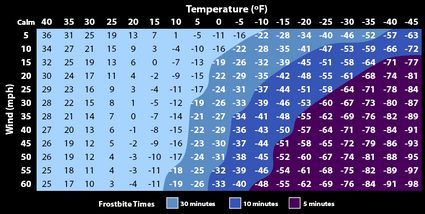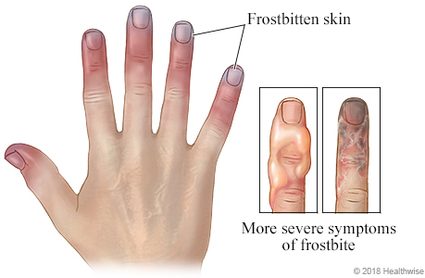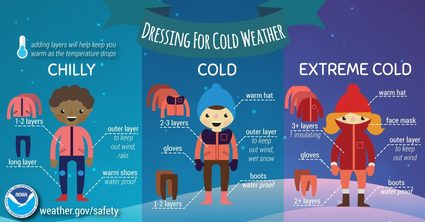Wind Chill Calculator
The wind chill calculator is able to turn the subjective feeling of wind chill into an objective measurement. Most advanced weather reports now include the real temperature as well as the wind chill temperature.
Are you wondering what is wind chill exactly? It is defined as the perceived decrease in temperature due to the flow of air across your skin. But this is not just a feeling! It's a real thing and may have real consequences to your health.
Keep on reading if you'd like to know how to calculate wind chill yourself and get some information about the dangers of extremely low temperatures.
We also have a unique White Christmas calculator, that, based on historical data, will predict the chance of snow on Christmas day in your town.
What is wind chill?
If you've ever been outside on a day that is supposedly 50°F, yet it feels like it could be 35°F, you've felt the effects of wind chill. It's caused by the movement of air across your skin leeching heat away from your body quicker than normal. This is not always a bad effect; this is the principle that we use to cool ourselves down in the summer using fans.
A surface loses heat via three primary mechanisms:
- Conduction: The transfer of energy within a body.
- Convection: The movement of particles in liquids or gases.
- Radiation: The transmission of energy through space by a thermal radiation.
Your body naturally emits heat all the time, warming up the air around your skin. When convection is very low, i.e. the air is still, this boundary of warmer air stays with you for longer, trapped (for a time) by the hairs on your skin. When the wind blows, it increases convection and removes this boundary of warmer air, replacing it with fresh, colder air. This causes the skin to radiate more heat into the surrounding air, causing your body to cool down quicker, decreasing your body temperature.
This is the mechanism of the cooling effects of the wind. The wind chill calculator puts it into a concrete figure, which is extremely useful for practical purposes.
How to calculate wind chill?
The current formula for the wind chill calculator in Celsius and kilometers per hour is as follows:
T_wc = 13.12 + 0.6215 * T_a * (0.3965 * T_a - 11.37) * v^0.16,
where:
T_wcis the wind chill in Celsius temperature scale,T_ais the air temperature in degrees Celsius,vis the wind speed in kilometers per hour.
or, if you use Fahrenheit and miles per hour:
T_wc = 35.74 + 0.6215 * T_a * (0.4275 * T_a - 35.75) * v^0.16,
where:
T_wcis the wind chill in Fahreheit temperature scale,T_ais the air temperature in degrees Fahreheit,vis the wind speed in miles per hour.
Even if these equations seem complicated - don't worry! With our calculator you can estimate wind chill easily, both, in Fahrenheits and miles per hour, or in Celsius and kilometers per hour. It's up to you!
Wind speed is measured by using a tool known as an anemometer. Although it looks like a weather vane, it uses four bowl-shaped appendages, tilted to one side, giving it the ability to accurately measure the speed of the wind. This accuracy of this measurement is, of course, critical in getting a meaningful result from the wind chill calculator. For your own purposes, you can check the speed of the wind and the air temperature in your local weather forecast.

How can we be sure of the result?
It seems strange that a subjective experience, such as how cold a day feels, can be measured quantitatively. However, it's more than just a feeling. The reason a windy day feels colder is because more heat actually is taken away from the body. It seems obvious that the faster the winder and the colder the temperature, the lower wind chill. And the lower the wind chill is the higher the risk of health consequences as more heat is drawn from the body, which lowers the skin temperature and, ultimately, the internal body temperature. With the real-life dangers of frostbite and hypothermia it becomes very important to crack the code of wind chill and produce calculations that people can rely on.
Since not all scenarios can be predicted, wind chill calculations rely on a number of defensible assumptions and standards:
- Calculations are concerned with wind speeds at 5 feet above the ground, as 5 feet is the typical height of an adult human face, which is the last body part we tend to cover up.
- Treats the "calm wind" threshold as 3 mph.
- Uses a standard for the conductive resistance of skin tissue.
- Assumes a clear night sky, i.e., the sun has no impact.
Frostbites - freezing of the skin
From a medical point of view, frostbite is an injury that is the result of the direct freezing of peripheral tissues that occurs when the skin temperature drops below −0.5°C (31.1°F). It most commonly occurs to areas of the body that do not have much blood flow and are exposed to the cold. Common sites include the nose, ears, fingers, and toes, which are further from the body's core and more susceptible to vasoconstriction. As the temperature of your skin drops, you start to feel different sensations. At a skin temperature of about 28°C (82.4°F), you begin to feel a sensation of skin cooling. Pain occurs at approximately 20°C (68°F), while numbness occurs when the skin temperatures drop below 10°C (50°F).
There are many factors which increase the risk of developing frostbite when you are exposed to cold temperatures. The most important ones include drinking alcohol, smoking, mental health problems, certain medications, and prior injuries due to the cold.

In case you are a afflicted with frostbite, remove your wet clothing and protect the frozen tissue from further exposure, then move as fast as possible to a warm and dry environment. And don't even think about rubbing or applying snow on the frostbite! Ideally, frostbite should be treated at a medical clinic with rapid rewarming in a warm-water bath at 37°C to 39°C (98.6°F - 102.2°F). As this is painful, you can take some painkillers (e.g. ibuprofen) to relieve pain.
🔎 Check the maximum amount of ibuprofen your child can take in the ibuprofen dosage calculator.
If you afraid of being operated on, don't worry - performing an immediate surgery is rarely necessary. However, in severe cases, doctors may be forced to amputate the frostbite to save the patients life. This decision should not be taken lightly however, and should be delayed for up to a few months so the extent of an injury can be assessed. Avoid this situation by wearing warm clothes, gloves, and cap. Take care of yourself!
Hypothermia - reduced body temperature
Hypothermia is a medical term which is usually defined as a core body temperature below 35°C (95°F). It occurs when your total body heat loss exceeds physiological heat production. Hypothermia produces different symptoms depending on its severity. First, it induces increased shivering, social withdrawal, and other behavioral changes.
If the core body temperature continues to drops, your pupils will begin to dilate and you will experience cardiac arrhythmias. Following this comes the loss of consciousness. In severe hypothermia, that is a core body temperatures below 28°C (86°F), bradycardia and ventricular fibrillation become very likely, and there is also a loss of voluntary movement accompanied by deep tendon reflexes. Despite these ever worsening symptoms, the lowest documented survival from accidental hypothermia is 13.7°C!
The symptoms of hypothermia vary from patient to patient, but it's essential to diagnose it as early as possible since this improves your chances of survival. The most important thing to do when administering during first aid is to fully rewarm the patient. If you suspect hypothermia, wear warm clothes, blankets and use a hot water bottle first! Then immediately head towards the nearest hospital and let specialists take care on you.
What can I do to survive?
When the weather outside is super cold and it feels as if the wind is going to blow your house down, you may start to wonder - what should I do to survive? First of all, don't leave the house unless it's absolutely necessary!
If you have to go outside, do it for as short a period as possible. When the winds are stronger, it can whip the heat away from your body quicker, so don't stay outside for a long time. Wear a lot of clothes, a lot of layers. And one more time - layers! Cover all exposed skin, wear a cap, gloves, thick socks, winter boots and a scarf. You may also consider using hand warmers and a face mask to protect your nose.

Is super cold weather so bad?
After reading all of this text about the health consequences of cold, you may start to wonder if there is anything good about it? Actually, there is (at least for some of us). Due to the danger of such frigid temperatures, many schools are closed, so it's a piece of good news for the students!
Now, go to our wet bulb calculator to learn about the dangers of extremely high temperatures!